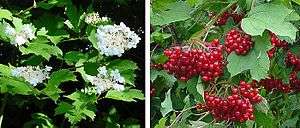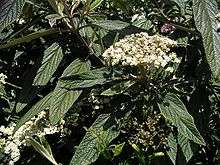Viburnum
< Horticulture| Viburnums | |
|---|---|
 | |
| Genus: | Viburnum |
| Family: | Adoxaceae |
| Transplant: | Transplants well |
| Disease issues: | Some serious |
| Weediness: | Most species freely self-seed |
| Pollination: | Insects |
Viburnum (Viburnum) is a genus of about 150-175 species of shrubs or (in a few species) small trees that were previously included in the family Caprifoliaceae. Genetic tests by the Angiosperm Phylogeny Group showed however that they are correctly classified in the family Adoxaceae.
They are native throughout the temperate Northern Hemisphere, with a few species extending into tropical montane regions in South America and southeast Asia. In Africa, the genus is confined to the Atlas Mountains.
Description
The leaves are opposite, simple, and entire, toothed or lobed; cool temperate species are deciduous, while most of the warm temperate species are evergreen. Some species are densely hairy on the shoots and leaves, with star-shaped hairs.
The flowers are produced in corymbs 5-15 cm across, each flower white to cream or pink, small, 3-5 mm across, with five petals, strongly fragrant in some species. The gynoecium has 3 connate carpels with the nectary on top of the gynoecium. Some species also have a fringe of large, showy sterile flowers round the perimeter of the corymb to act as a pollinator target.
The fruit is a spherical, oval or somewhat flattened drupe, red to purple, blue, or black, and containing a single seed; they are eaten by birds and other wildlife, and some are edible for humans (though many others are mildly poisonous to people).

Growing Conditions
Viburnums grow best in moist, fertile, well-drained, and deep soils. Sunlight requirements vary according to species.
Species

|
|
- The hybrid Viburnum × bodnantense (V. farreri × V. grandiflorum) is particularly popular for its strongly scented pink flowers on the leafless deciduous shoots in mid to late winter.
- Viburnum × burkwoodii (V. carlesii × V. utile)
- Viburnum × carlcephallum (V. carlesii × V. macrocephalum)
- Viburnum carlesii has flowers that look somewhat like snowballs, excellent fragrance, dense structure, and reddish leaves in autumn.
- Viburnum davidii is an evergreen species from China with blue fruit.
- Viburnum dentatum has flat-topped flowers, bluish fruit, and reddish leaves in autumn. It is somewhat salt tolerant. The cultivar 'Blue Muffin' is more compact than the species and has fruit that are a deeper blue than the species.
- Viburnum dilatatum has flat-topped flowers, reddish leaves in autumn, and bright red fruit that persist into winter.
- Viburnum × juddii (V. bitchiuense × V. carlesii)
- Viburnum plicatum has white, snowball-like flowers, textured leaves, reddish-black fruit, and can grow quite large under ideal conditions. The species can tolerate shade, but not drought. The variety tomentosum has flat-topped flowers but is otherwise the same as the species.
- Viburnum × pragense (V. rhytidophyllum × V. utile)
- Viburnum × rhytidophylloides (V. lantana × V. rhytidophyllum)
- Viburnum rhytidophyllum is a popular evergreen species, grown mainly for its foliage effect of large, dark green leathery leaves with strongly wrinkled surface. This is the parent species of two popular hybrid cultivars known as 'Alleghany' and 'Pragense'. 'Alleghany' was selected from a hybrid between V. rhytidophyllum and V. lantana 'Mohican' (in 1958, at the US National Arboretum).
- Viburnum setigerum has upright, coarse structure and orange to reddish-orange fruit.
- Viburnum sieboldii has coarse, open structure, flat-topped flowers, reddish-black fruit, and can grow as a small tree.
Uses
Many species of viburnum have become popular as garden or landscape plants because of their showy flowers and berries and generally good autumn color.
In prehistory, the long straight shoots of some viburnums were used for arrow shafts.
Maintenance
Prune after flowering, as the flower buds are produced the previous year.
Propagation
Propagated through cuttings or seed, hybrids and some cultivars may be grafted.
Most species can be grown as cutback shrubs.
Pests and diseases
References
- Britton, Nathaniel Lord; Addison Brown (1913). An Illustrated Flora of the Northern United States and Canada, Volume 3 (second edition ed.). Dover Publications, inc.. pp. 269-274.
- Ann Fowler Rhoads and Timothy A. Block (2000). The Plants of Pennsylvania: An Illustrated Manual. Anna Anisko, illustrator. Morris Arboretum, University of Pennsylvania Press. pp. 318-323.
- Christopher Brickell and Judith D. Zuk (1997). The American Horticultural Society A-Z Encyclopedia of Garden Plants. DK Publishing. pp. 1048-1051.
- Staff of the L. H. Bailey Hortorium (1976). Hortus Third: A Concise Dictionary of Plants Cultivated in the United States and Canada. Cornell University Press. pp. 1153-1155.
- Pirone, Pascal P. (1978). Diseases & Pests of Ornamental Plants (Fifth Edition ed.). John Wiley & Sons, New York. pp. 189-190.
- Cranshaw, Whitney (2004). Garden Insects of North America: The Ultimate Guide to Backyard Bugs. Princeton University Press. pp. 625.
- Pippa Greenwood, Andrew Halstead, A.R. Chase, Daniel Gilrein (2000). American Horticultural Society Pests & Diseases: The Complete Guide to Preventing, Identifying, and Treating Plant Problems (First Edition ed.). Dorling Kindersley (DK) Publishing, inc.. pp. 197.